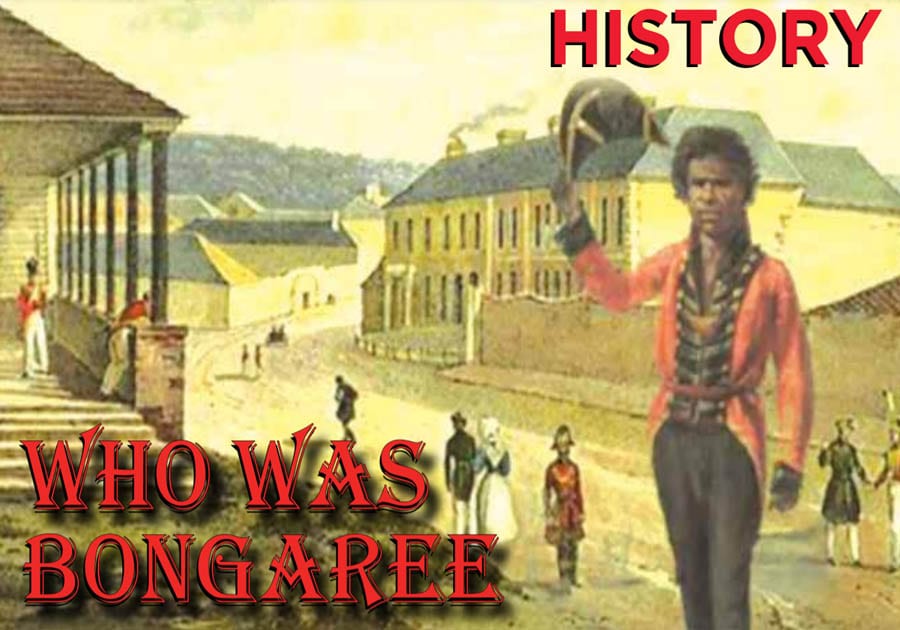BONGAREE is perhaps the most famous of all Australian aborigines, after whom the first settlement on Bribie Island was named. It got this name 113 years after Bongaree first came here, with another suggestion it be called “Banya”. On 16th July 1799, the sloop NORFOLK brought the first white men, and the Sydney native Bongaree, into Moreton Bay. They made their first landing about where the Seaside Museum stands today, making this location the “Cradle Site of Queensland”.
Bongaree was the first man ashore, making first contact with the local Joondoburri people, while Matthew Flinders with his much-traveled cat Trim, and the rest of the crew waited on the boat. Bongaree had been included in the expedition, having built good relationships with the early white settlers, to help local contact and communication. This proved quite difficult, as there were more than 500 different tribal and language groups throughout Australia, and the native groups in Moreton Bay all spoke slightly different languages. Bongaree acted as interpreter and go-between. Flinders said of him, “He often stood naked and unarmed between blacks and whites, the symmetry of his limbs expressing strength and agility”
THE MAN BONGAREE
Bongaree was the first person called an “Australian”.
Bongaree, also known as BUNGAREE, was born in 1775 and was 24 years old when he came to Bribie Island, and Matthew Flinders was just 25. They were good companions, and Bongaree later accompanied Flinders and others on many voyages of exploration, including the first circumnavigation of the continent of Australia aboard the “Investigator” in 1804.
There are 17 surviving portraits of Bongaree/Bungaree, but only a handful of likenesses of the outstanding explorer and cartographer Matthew Flinders, and even less of other naval explorers and Governors whom Bongaree assisted. Such was the interest and regard for this very colourful man.
One famous paintings of Bongaree by Augustus Earle in 1826 shows him in scarlet jacket and cocked hat, raised in salute, with brass plate on his chest. With Sydney Harbour in the background, he cast Bongaree in the pose of a landowning gentleman, parodying colonial society and emphasising the tragedy of indigenous people and loss of their native land.
In 1815, Governor Lachlan Macquarie proclaimed him a “King” and presented him with a brass plate; a Gorget hung around the neck, and gave him land at Georges Head in Sydney. Governor Brisbane presented Bongaree with an old military uniform, complete with sword, which he wore with pride. Every Governor from Macquarie to Gipps supplied him with old cocked hats, as did almost every regimental commander.
He was a popular and colourful character around the streets of Sydney, and he was a great mimic of previous governor’s mannerisms ….but never the current Governor. On the day before his departure to England in 1822, Macquarie went to Georges Head to visit Bongaree for the last time, to introduce him to his successor Sir Thomas Brisbane, who promised Bongaree a new fishing boat and nets.
REGARD FOR BONGAREE
Army personnel saluted him as they passed him in the street. He was thrilled and honoured when the Royal Navy invited him to live at Garden Island as their guest, and the Government paid him a full daily ration. When new ships arrived through Sydney Heads, Bongaree would meet them in full uniform, in his fishing boat, with a couple of his wives, climb aboard and welcome newcomers to “his” country. The Sydney Gazette described him as a “Native distinguished by his remarkable courtesy”. He mocked the white men by mocking himself.
In 1828 Bongaree and his clan moved their camp to the Governors Domain, where he was seen “naked and in the last stages of human infirmity”.
Affected by age, alcohol and malnutrition, Bongaree was admitted to hospital with a serious illness that lingered for several months. He died at Garden Island on 24 November 1830, aged 55. He was buried at Rose Bay beside his late wife. History records that during his life Bongaree had six wives who went by the names “Askabout, Boatman, Broomstick, Onion & Pincher “ and his last wife Queen Gooseberry survived him by over 20 years.//Bongaree had accompanied Matthew Flinders on the first circumnavigation of the entire continent TERRA AUSTRALIS, which 14 years later was officially named AUSTRALIA. This GREAT SOUTH LAND was visited by various nations in the previous 120 years, known as NEW HOLLAND by the Dutch, but it was James Cook who first claimed the East Coast in 1770, naming it initially NEW WALES, and later NEW SOUTH WALES. Flinders and Bongaree proved it was one large Continent, later called AUSTRALIA.
BONGAREE ON BRIBIE
The name Bongaree was given to the first settlement here on Bribie Island when land was first offered for sale in 1912. The Brisbane Tug & Steamship Co. had invested to develop it as a tourist destination, and the company director, G.P.CAMPBELL wanted it to be called BANYA. A letter written to the Lands Office in October 1912 requested that But it was too late……… the name Bongaree had already been decided. I think there should be greater recognition of the great man BONGAREE on Bribie Island. Any other town would be so proud to have this historical connection. Perhaps we could have a statue of the man named Bongaree erected at the place called Bongaree.
